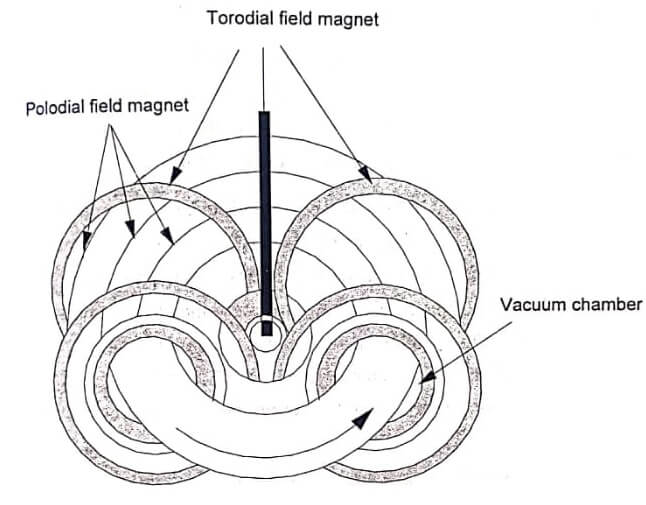A reactor of this shape is a called a tokamak. The most well known of the nuclear fusion test reactors is the TFTR at Princeton. It is a magnetic confinement reactor using the toroidal geometry of the tokamak, a device first developed in the USSR. It uses a combination of two magnetic fields to confine and control the plasma. One is provided by the doughnut shaped set of external coils which provides a magnetic field along the axis of the toroid called toroidal field.
The other is generated by the large heating current along the toroid which heats the plasma; it is a called a poloidal field. This heating current is induced by changing magnetic fields in central induction coils and exceeds a million amperes. In addition to the plasma heating by this axial current, the plasma is heated by intense beams of neutral atoms which are injected into the plasma.
Microwaves, electricity and neutral particle beams from accelerators heat a stream of hydrogen gas. This heating turns the gas into plasma. This plasma gets squeezed by super conducting magnets, thereby allowing fusion to occur. The most efficient shape for the magnetically confined plasma is a donut shape (toroid).
The ITER tokamak will be a self contained reactor whose parts are in various cassettes. These cassettes can be easily inserted and removed without having to tear down the entire reactor for maintenance. The tokamak will have a plasma toroid with a 2-meter inner radius and a 6.2- meter outer radius. This reactor has reached a temperature a of 4×108 K, above the critical ignition temperature for D-T fusion, and has approached very close to the Lawson criterion, although not at the same time.
Inertial Confinement Fusion Reactors
The National Ignition Facility (NIF) at Lawrence Livermore Laboratory is experimenting with using laser beams to induce fusion. In the NIF device, 192 laser beams will focus on single point in a 10- meter-diameter target chamber called a hohlraum. A hohlraum is a cavity whose walls are in radiative equilibrium with the radiant energy within the cavity.
At the focal point inside the target chamber, there will be a pea-sized pellet of deuterium-tritium encased in a small, plastic cylinder. The power from the lasers (1.8 million joules) will heat the cylinder and generate X-rays. The heat and radiation will convert the pellet into plasma and compress it until fusion occurs.
The fusion reaction will be short-lived, about one-millionth of a second, but will yield 50 to 100 times more energy than is needed to initiate the fusion reaction. A reactor of this type will have multiple targets that will be ignited in succession to generate sustained heat production.

While magnetic confinement seeks to extend the time that ions spend close to each other in order to facilitate fusion, the inertial confinement strategy seeks to fuse nuclei so fast that they don’t have time to move apart. The two approaches to inertial confinement have been laser fusion and ion-beam fusion.
Directed onto a tiny deuterium-tritium pellet, the enormous energy influx evaporates the outer layer of the pellet, producing energetic collisions which drive part of the pellet inward. The inner core is increased a thousand fold in density and its temperature is driven upward to the ignition point for fusion. Accomplishing this in a time interval of 10-8 to 10-9 seconds does not allow the ions to move appreciably because of their own inertia; hence the name inertial confinement.
Laser fusion:
Laser fusion attempts to force nuclear fusion in tiny pellets or micro-balloons of a deuterium tritium mixture by zapping them with such a high energy density that they will fuse before they have time to move away from each other. This is an example of inertial confinement.
Ion-beam fusion:
If a high energy beam of electrons or other particles can be directed onto a tiny pellet or micro balloon of deuterium tritium mixture, it could cause it to explode like a miniature hydrogen bomb, fusing the deuterium and tritium nuclei in a time frame too short for them to move apart.
| Read More Topics |
| Gas cooled reactor |
| Reactive power and voltage |
| Methods of voltage control |






